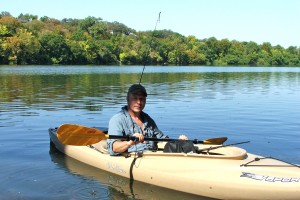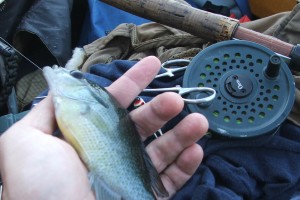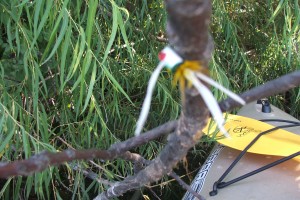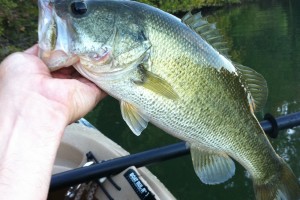I SPOTTED THE FLASH from the corner of my eye. Something big was hunting the shallows off the river’s main current and it sent fry in mirrored sprays. I back-paddled to slow my float, aligned my bow and traded paddle for rod. My lure swooped down toward the flitting fish. This was going to be good.


Just then my lure nipped a limb, wrapping three times around another and perched on a third. I swore to myself. The fish fled. Fumbling, I tucked my reel between my knees and paddled toward the overhanging limbs. There, teeter-tottering to free my lure, it hit me:
Fishing and kayaking are the best and the worst of siblings. There’s nothing like it when they work together, but it’s also against their nature. Fishing begs for big strikes, surprises and action—it’s always looking for a fight. Kayaking needs balance, fair warning and no sudden movements.
One demands two hands on the paddle. The other, two on the rod. So, there sits the kayak angler—me–the middle child, plopped down with a four-handed job and a balancing act. Neglect the paddle and swim. Or, overlook the rod and risk a hook piercing and tetanus shot.
But kayak fishing isn’t really so hard, even though my balance isn’t particularly good. I can’t recall having ever accidentally flipped while fishing. Maybe it’s because my dad taught me the two skills separately.
When we started fishing from the canoe, I tossed a few rods into Mississippi’s Pascagoula River, but we stayed dry.
Here is how you can too:
Technical Instruction & Practice:
A basic kayaking class will likely cover paddling, entering and exiting the watercraft, basic water reading skills and safety. You’ll also get time on the water without the distraction of a fishing rod. If you forego the lessons, launch your kayak from a sandbar. Get your bottom in the seat as quickly and gracefully as you can. Use the first few trips to learn the boat, explore the water and scout fishing spots. Only bring fishing gear when you are comfortable in the kayak.
Fishing guides are great sources of information and can be found most anywhere. If you’d rather teach yourself, learn to tie a few knots and see before you buy your gear. Practice fishing from the bank until you’re comfortable casting, landing and releasing fish. Then try the kayak.
Maintain a low center of gravity. Keep yourself and your gear tight to the kayak’s centerline. Don’t lean heavily to the sides. Move smoothly. Look ahead for rocks, logs, or fishing spots, so you have time to prepare calmly for whatever lay ahead.
Pack Light, Pack Right
Poor gear selection and packing choices can ruin your day. They’ve ruined a few of mine. Bring what you need and can carry in a comfortable and accessible way. Load your kayak with the heaviest items along the centerline. If the kayak lists, repack.
Casting
Aim the kayak’s bow at your target for the most stable casting scenario. Cast forward with your elbow tucked along the boat’s centerline. Avoid exaggerated movements. You can cast sideways, but you risk losing accuracy and stability.
Tree Limbs & Tight Lines
I catch a tree limb on every trip. One morning I forgot to pay out the line after hooking a limb. I reached for my paddle. The line tightened and snatched my rod from the boat.
If your hook hangs on something, give out some slack. Otherwise the taut line can set a booby trap. I once saw a tight line send a hook into a guy’s neck after he released his lure from a snag. At the hospital the doctor pushed the hook through the other side, clipped the barb and slid the hook out of his neck. They finished him off with a tetanus shot.
Catching
When that big strike comes, instinct screams rare back, bury the hook! Instinct will get you wet. The trick is to give a controlled hook set and play the fish to the boat without breaking the centerline or raising your center of gravity too much. Net the fish without leaning over the boat.
***
I made two more strokes towards the 100-year-old cypress then laughed at my tree tangle. A Great Blue heron stalked the back of the cove.
Smelled like fish. An easy cast over the bow sent my lure to the base of a cypress knee. Perfect. A congregation of Red Eared Slider turtles watched from their log pew. Then I felt it. Fish on! I kept my cool. The boat was steady. I coerced the fish to the kayak with one hand.
With the other, I grabbed the net from my left hip and landed the fish. The reel at my feet, I unclipped the hemostats from my life vest and removed the hook. My camera was tucked at my right hip, making it easy to get a quick photo without distressing the fish. At the water’s surface, I cradled the catch. It regained strength and darted off. I rinsed my hands, checked my lure, looked upstream and picked up the paddle.
In that moment, I knew that I had tempered the two siblings.



